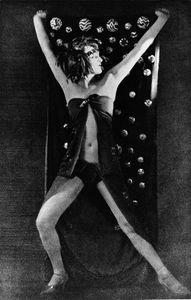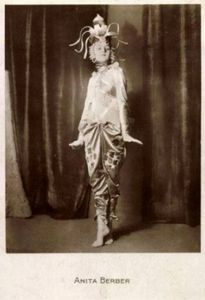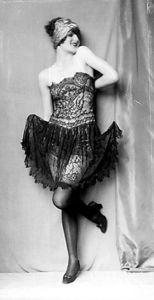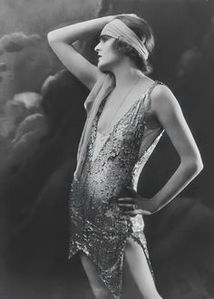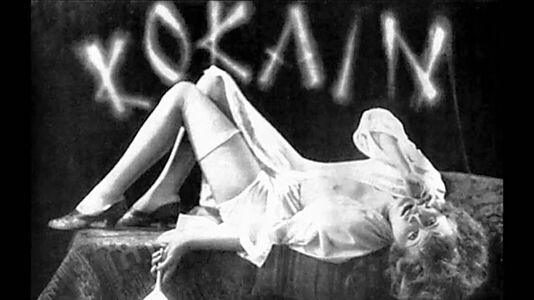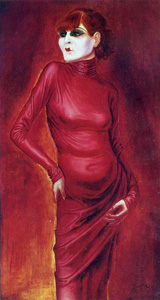Anita Berber
| Anita Berber | ||
 Anita Berber (1920s) | ||
| Background information | ||
| Born | Jun 10, 1899 Leipzig, Kingdom of Saxony, German Empire | |
| Died | Nov 10, 1928 - at age 28 Berlin-Kreuzberg, Weimar Republic | |
| Parents: | Felix Berber (father) Lucie Berber (mother) | |
| Occupation: | Dancer, actress, writer | |
Anita Berber (✦10 June 1899 – †10 November 1928) was a German dancer, actress, and writer who was the subject of an Otto Dix painting. She lived during the time of the Weimar Republic.
Early life
Born in Leipzig to Felix Berber, First Violinist with the Municipal Orchestra, and his wife, Lucie Berber, a cabaret singer and dancer, who later divorced when Berber was four. Berber was raised mainly by her grandmother in Dresden. In 1913 Berber studied dance at Émile Jaques-Dalcroze's school in Hellerau, which included training in rhythmic gymnastics, harmony, and music. The next year she left to study ballet in Berlin with Rita Sacchetto. By the age of 16, she had made her debut as a cabaret dancer, and in 1917 she was working as a fashion model for "Die Dame".
Notoriety in Berlin
Between 1918 and 1925, she appeared in twenty-five films. Richard Oswald used her in a number of his films around this time. In 1920 she appeared alongside Dadaists in a political cabaret called Schall und Rauch.
Scandalously androgynous, she quickly made a name for herself. She wore heavy dancer's make-up, which on the black-and-white photos and films of the time came across as jet black lipstick painted across the heart-shaped part of her skinny lips, and charcoaled eyes. Berber's hair was fashionably cut into a short bob and was frequently bright red, as in 1925 when the German painter Otto Dix painted a portrait of her, titled Portrait of the Dancer Anita Berber.
Her dancer, friend, and sometime lover Sebastian Droste, who performed in the film "Algol" (1920), was thin and had black hair with gelled-up curls much like sideburns. Neither of them wore much more than low-slung loincloths, and Anita occasionally had a corsage placed well below her breasts.
Berber and Droste collaborated on a book titled "Dances of Vice, Horror, and Ecstasy" in 1923. Around 1,000 copies were published, and even prominent artist Hannah Höch owned a copy.
Berber's dances – which had names such as "Cocaine" and "Morphium" – broke boundaries with their androgyny and total nudity, but it was her public appearances that really challenged social taboos. Berber's overt drug addiction and bisexuality were matters of public gossip. In addition to her addiction to cocaine, opium, and morphine, one of Berber's favorite forms of inebriation was chloroform and ether mixed in a bowl. This would be stirred with a white rose, the petals of which she would then eat.
Karl Toepfer contends that no one of this era was "more closely associated with nude dancing than Anita Berber". A contemporary of Berber, choreographer Joe Jencik, described how "The public never appreciated Anita's artistic expression, only her public transgressions in which she trespassed the untouchable line between the stage and the audience. . . . She sacrificed her person to a self-vivisection of her life."
Aside from her addiction to narcotic drugs, Berber was also an alcoholic. In 1928, at the age of 29, she suddenly gave up alcohol completely but died later the same year. According to Mel Gordon, in "The Seven Addictions and Five Professions of Anita Berber: Weimar Berlin's Priestess of Debauchery", she had been diagnosed with severe tuberculosis while performing abroad. After collapsing in Damascus, she returned to Germany and died in a Kreuzberg hospital on 10 November 1928, although rumor had it that she died surrounded by empty morphine syringes. Berber was buried in a pauper's grave in St. Thomas Cemetery in Neukölln.
- Anita Berber 1922 queen of Depravity
Marriages
In 1919, Berber entered into a marriage of convenience with a man with the surname Nathusius. She later left him to pursue a relationship with a woman named Susi Wanowski, and became part of the Berlin lesbian scene.
Berber's second marriage, in 1922, was to Sebastian Droste. This lasted until 1923. In 1925, she married an American dancer named Henri Châtin Hofmann. They embarked on a European tour ending in Zagreb after Berber was arrested for insulting the King. After Hofmann managed to secure her release, they continued around the Mediterranean and the Middle East.
Notes
Data from Google Lens
The image features Anita Berber, a German dancer, actress, and cabaret artist known for her provocative performances and scandalous lifestyle during the Weimar Republic era. This particular image captures her in a pose characteristic of the flapper style of the 1920s, showcasing her iconic look and the fashion of the era.
- Weimar Republic Icon: Berber embodied the decadence and artistic freedom of 1920s Berlin, challenging social norms with her performances and lifestyle.
- Controversial Performer: She was known for her nude and sexually explicit dances, which were considered highly scandalous at the time.
- Subject of Art: The renowned German artist Otto Dix painted a famous portrait of her in 1925, titled "The Dancer Anita Berber," capturing her distinctive appearance.
- Tragic Figure: Despite her fame, Berber struggled with drug and alcohol addiction and died at the young age of 29.
External links
Chat rooms • What links here • Copyright info • Contact information • Category:Root
